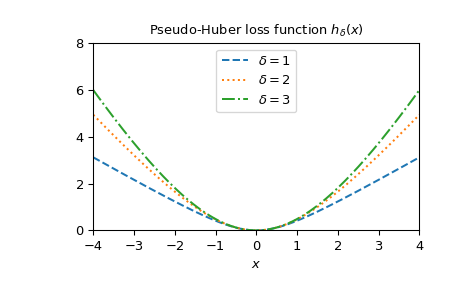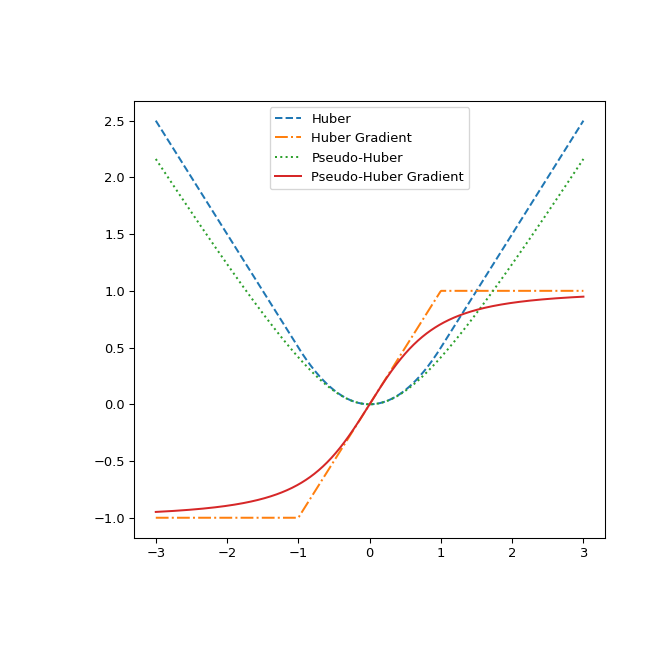scipy.special.pseudo_huber#
- scipy.special.pseudo_huber(delta, r, out=None) = <ufunc 'pseudo_huber'>#
Pseudo-Huber loss function.
\[\mathrm{pseudo\_huber}(\delta, r) = \delta^2 \left( \sqrt{ 1 + \left( \frac{r}{\delta} \right)^2 } - 1 \right)\]- Parameters:
- deltaarray_like
Input array, indicating the soft quadratic vs. linear loss changepoint.
- rarray_like
Input array, possibly representing residuals.
- outndarray, optional
Optional output array for the function results
- Returns:
- resscalar or ndarray
The computed Pseudo-Huber loss function values.
See also
huberSimilar function which this function approximates
Notes
Like
huber,pseudo_huberoften serves as a robust loss function in statistics or machine learning to reduce the influence of outliers. Unlikehuber,pseudo_huberis smooth.Typically, r represents residuals, the difference between a model prediction and data. Then, for \(|r|\leq\delta\),
pseudo_huberresembles the squared error and for \(|r|>\delta\) the absolute error. This way, the Pseudo-Huber loss often achieves a fast convergence in model fitting for small residuals like the squared error loss function and still reduces the influence of outliers (\(|r|>\delta\)) like the absolute error loss. As \(\delta\) is the cutoff between squared and absolute error regimes, it has to be tuned carefully for each problem.pseudo_huberis also convex, making it suitable for gradient based optimization. [1] [2]Added in version 0.15.0.
Array API Standard Support
pseudo_huberhas experimental support for Python Array API Standard compatible backends in addition to NumPy. Please consider testing these features by setting an environment variableSCIPY_ARRAY_API=1and providing CuPy, PyTorch, JAX, or Dask arrays as array arguments. The following combinations of backend and device (or other capability) are supported.Library
CPU
GPU
NumPy
✅
n/a
CuPy
n/a
✅
PyTorch
✅
⛔
JAX
⚠️ no JIT
⛔
Dask
✅
n/a
See Support for the array API standard for more information.
References
[1]Hartley, Zisserman, “Multiple View Geometry in Computer Vision”. 2003. Cambridge University Press. p. 619
[2]Charbonnier et al. “Deterministic edge-preserving regularization in computed imaging”. 1997. IEEE Trans. Image Processing. 6 (2): 298 - 311.
Examples
Import all necessary modules.
>>> import numpy as np >>> from scipy.special import pseudo_huber, huber >>> import matplotlib.pyplot as plt
Calculate the function for
delta=1atr=2.>>> pseudo_huber(1., 2.) 1.2360679774997898
Calculate the function at
r=2for different delta by providing a list or NumPy array for delta.>>> pseudo_huber([1., 2., 4.], 3.) array([2.16227766, 3.21110255, 4. ])
Calculate the function for
delta=1at several points by providing a list or NumPy array for r.>>> pseudo_huber(2., np.array([1., 1.5, 3., 4.])) array([0.47213595, 1. , 3.21110255, 4.94427191])
The function can be calculated for different delta and r by providing arrays for both with compatible shapes for broadcasting.
>>> r = np.array([1., 2.5, 8., 10.]) >>> deltas = np.array([[1.], [5.], [9.]]) >>> print(r.shape, deltas.shape) (4,) (3, 1)
>>> pseudo_huber(deltas, r) array([[ 0.41421356, 1.6925824 , 7.06225775, 9.04987562], [ 0.49509757, 2.95084972, 22.16990566, 30.90169944], [ 0.49846624, 3.06693762, 27.37435121, 40.08261642]])
Plot the function for different delta.
>>> x = np.linspace(-4, 4, 500) >>> deltas = [1, 2, 3] >>> linestyles = ["dashed", "dotted", "dashdot"] >>> fig, ax = plt.subplots() >>> combined_plot_parameters = list(zip(deltas, linestyles)) >>> for delta, style in combined_plot_parameters: ... ax.plot(x, pseudo_huber(delta, x), label=rf"$\delta={delta}$", ... ls=style) >>> ax.legend(loc="upper center") >>> ax.set_xlabel("$x$") >>> ax.set_title(r"Pseudo-Huber loss function $h_{\delta}(x)$") >>> ax.set_xlim(-4, 4) >>> ax.set_ylim(0, 8) >>> plt.show()

Finally, illustrate the difference between
huberandpseudo_huberby plotting them and their gradients with respect to r. The plot shows thatpseudo_huberis continuously differentiable whilehuberis not at the points \(\pm\delta\).>>> def huber_grad(delta, x): ... grad = np.copy(x) ... linear_area = np.argwhere(np.abs(x) > delta) ... grad[linear_area]=delta*np.sign(x[linear_area]) ... return grad >>> def pseudo_huber_grad(delta, x): ... return x* (1+(x/delta)**2)**(-0.5) >>> x=np.linspace(-3, 3, 500) >>> delta = 1. >>> fig, ax = plt.subplots(figsize=(7, 7)) >>> ax.plot(x, huber(delta, x), label="Huber", ls="dashed") >>> ax.plot(x, huber_grad(delta, x), label="Huber Gradient", ls="dashdot") >>> ax.plot(x, pseudo_huber(delta, x), label="Pseudo-Huber", ls="dotted") >>> ax.plot(x, pseudo_huber_grad(delta, x), label="Pseudo-Huber Gradient", ... ls="solid") >>> ax.legend(loc="upper center") >>> plt.show()
